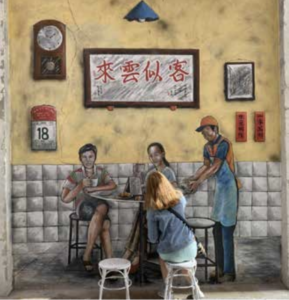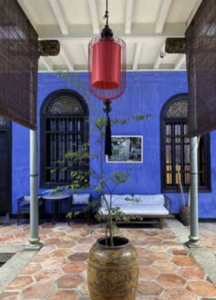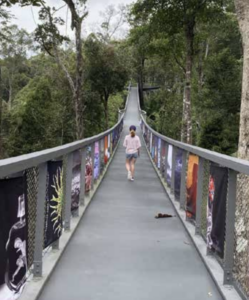By Rachel Laramee
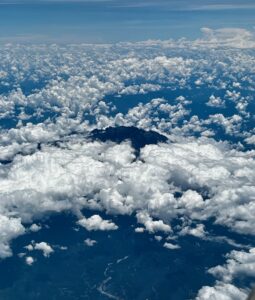 Ever considered climbing Mount Kinabalu? At 4,095 meters (13,435 feet) above sea level, it’s the highest peak in Borneo, and the hike to the top features tons of interesting geology and rare flora and fauna, making it a must-do for adventurous, outdoorsy types.
Ever considered climbing Mount Kinabalu? At 4,095 meters (13,435 feet) above sea level, it’s the highest peak in Borneo, and the hike to the top features tons of interesting geology and rare flora and fauna, making it a must-do for adventurous, outdoorsy types.
Being only somewhat outdoorsy and not particularly adventurous, I’m more interested in the walk-in-the-woods aspect than the scaling-peaks aspect. And then when I saw said peak through the window of plane at cruising altitude, my doubts blossomed into trepidation.
Luckily, lots of people in our community have done it, so I have some knowledge to tap (and now so do you)! The official website says it’s “one of the highest peaks in the world that is easily trekked by most people,” but (spoiler alert) a lot of people said it wasn’t easy. They did all say it was very doable, however, and very rewarding.
What’s it like to climb Kinabalu? Read on for insights and reflections from folks who lived to tell the tale.
When did you climb Kinabalu?
Ruth: March 2019
Lai: February 2020
Karan: July 2022
Roshini: March 2023
What was most physically challenging?
Ruth: The last 2 hours of the descent was most challenging, as it is tough on the hips and knees—jelly legs feel a bit disconcerting!
Lai: Right after the summit climb, doing the Low’s Peak Circuit via ferrata, which took me about 3.5 hours to complete. Via Ferrata is a mountain route equipped with fixed cables, rungs, rails and bridges embracing Mount Kinabalu’s Panalaban rock face. It is the world’s highest via ferrata and requires some upper body strength, endurance, as well as balance walking on narrow bridge and rope with steep drops.
Karan: The descent. Nobody trains to walk down.
Roshini: The second day hike to the summit at 2:30 a.m. Fighting against the elevation, walking in the dark, the cold wind blowing against your face and the exhaustion from lack of sleep.
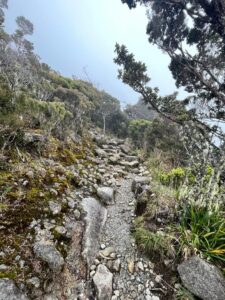 What was most mentally and emotionally challenging?
What was most mentally and emotionally challenging?
Ruth: The anticipation was the most challenging. I feared that it would be too difficult or that I might be affected by the altitude. The reality was that it was much easier and more enjoyable (glorious weather and great friends contributed) going up to Laban Rata (base camp) than I expected. I was anxious setting off in the dark but quickly got my bearings due to the trail of people’s head torches ahead. There was one instance where I felt disoriented for about 5 minutes, but it quickly passed.
Lai: Hiking to the summit early in the morning. It was cold and windy, yet I had to push myself to reach the summit and LPC starting point by the cut-off times. (Via Ferrata climbers have cut-off times to reach the base camp Pendant Hut on Day 1—because there will be a mandatory safety briefing and training session on how to use the equipment—and cut-off times to reach the summit, and via ferrata starting points. Climbers who fail to arrive on time will be exempted from via ferrata activity.)
Karan: The beeline to the top can be a crush of people trying to pass each other. It was hard to keep my cool.
Roshini: More than the physical challenge it was a lot to do with the mental struggle. Talking to oneself and saying that you could keep going and push a little harder though the journey seems long and never ending.
Did anything surprise you?
Ruth: I was surprised that there were toilets at most of the rest stops, as I had heard from others (maybe from long ago) that there were no facilities. I was awed by the amazing sherpas carrying up incredible weights of supplies to Laban Rata. Their speed was definitely a motivator to keep up the pace, watching them fly past wearing flip-flops and carrying heavy loads. And finally, I was surprised by how much I enjoyed the whole experience—the scenery is breathtaking.
Lai: Having to trek through an unexpected alpine forest trail within the LPC route. It was a raw trail, so I had to watch my steps and head!
Roshini: The amount of willpower one has is truly tested on this hike. I was surprised how much willpower and strength I had within, of course apart from the encouragement from the group of ladies I hiked with, which kept me going and I made it to the summit!
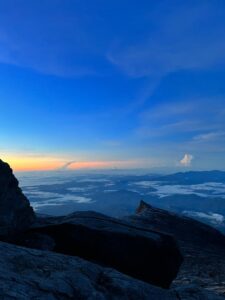 What kind of training do you recommend? (In flat terrain, how do you train for hills? Or is general strength/cardio/endurance enough?)
What kind of training do you recommend? (In flat terrain, how do you train for hills? Or is general strength/cardio/endurance enough?)
Ruth: At the time we lived on the 30th floor of an apartment block, so I would walk up and down the service stairs from the basement to the 42nd floor. Training to walk downhill/downstairs is absolutely as important as training to go up! Overall fitness is important if you want to enjoy the experience, but you don’t need to be an athlete.
Lai: Being physically prepared certainly helps. Focus on stamina, endurance and strength training. Hit the gym to strengthen your legs (and upper body for Via Ferrata). Walking on inclined treadmill and stepper machine can help to condition your legs for the climb if you have no access to hills. Go for outdoor hikes.
Karan: I think whatever you do just strive to elevate your heartrate for a minimum 45 minutes every day and longer as you get closer to D-day.
Roshini: If I could be very frank, nothing and absolutely nothing can train you for this hike! It’s something you will experience when you are there! Everyone’s experience is unique and different. Having said that, we were recommended to do the stair stepper and inclined treadmill walks to train our quads, which we did for a month at least.
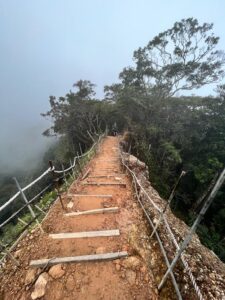 What equipment is essential? What is optional but recommended?
What equipment is essential? What is optional but recommended?
Ruth: A head torch is essential for the early start on the second day, and walking poles are highly advisable. Comfortable hiking shoes are essential, and they must have enough space in the toe because on the descent you will be constantly pressing on that area. If the weather is moderate, a trail shoe is adequate, but if it is very wet, waterproof boots are preferable. Layering clothing is key to a comfortable climb. It can be hot on the way up, in which case a t-shirt is adequate. It is extremely cold at the summit, so gloves, a warm coat, hat and so on are essential. Altitude sickness tablets are a personal decision. I didn’t take them and instead took paracetamol when I went to sleep—I was fine.
Lai: Climbing gloves are essential for the Via Ferrata activity because you need to grip the steel cables and rungs and wouldn’t want to end up with bad abrasions.
Karan: Essential: well-worn and grippy shoes, extra batteries, gloves, headlamp, don’t skip the meal before the 2 a.m. assault to the top! Optional: walking sticks for the walk down.
Roshini: A detailed list of things that are essential to be carried on the hike is available on the website of your travel agent, and it definitely was very helpful.
What was recovery like?
Ruth: Again, I was pleasantly surprised by the quick and relatively pain-free recovery time. A little stiff in the hips, but otherwise my feet were fine and no other complaints after a good night of sleep.
Lai: My arms and legs were sore for the next few days, and I avoided stairs if I could!
Karan: Well-earned rest for a few days.
Roshini: Sleep, sleep and a lot of sleep! The body had gone through so much that I had to give it one whole week to just relax and recoup.
Anything else you want to share about the place or the experience?
Ruth: It was emotional to reach the summit and watch the sunrise. I felt an enormous sense of achievement, especially as I would not describe myself as a naturally adventurous person. We stayed at Sanctuary Lodges in the National Park the night before we set off, and this was a lovely way to experience the mountain views and get excited about the climb. In hindsight we were a little competitive about doing it in good time, and now I wish I had spent longer enjoying the views on the way up. As we were a group of 7 we had a room to ourselves at Laban Rata, with an en suite, but there are various sharing options. The water in the shower was absolutely freezing, so don’t expect any luxury, but it is perfectly doable. This really is a bucket list experience, and I am so glad I did it. I highly recommend it, though I do acknowledge that we had perfect weather and this definitely influenced my experience!
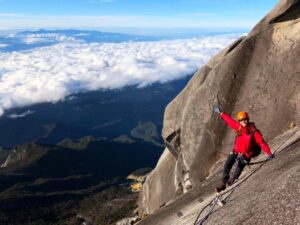 Lai: Via Ferrata takes the adventure to a whole new level. The spectacular views made it all worthwhile. If you love extreme challenges and are not afraid of heights, I recommend adding the Via Ferrata activity to enhance your hike experience.
Lai: Via Ferrata takes the adventure to a whole new level. The spectacular views made it all worthwhile. If you love extreme challenges and are not afraid of heights, I recommend adding the Via Ferrata activity to enhance your hike experience.
Karan: It’s a magical place. Never take for granted the privilege it is to come and visit it.
Roshini: My personal experience on my hike was very challenging, but after you reach the summit and take a minute to let the feeling sink in, you will truly find it AMAZING and worth all the effort that you put into it. Also, do not take it as a race to reach the basecamp or the summit. Enjoy the hike and nature’s beauty as you climb. I definitely recommend doing the hike if you are able to do so! Good luck!
